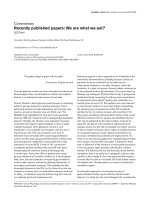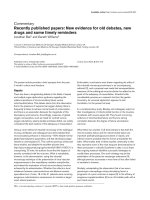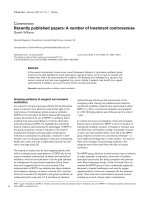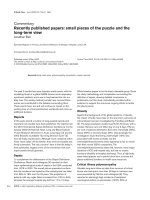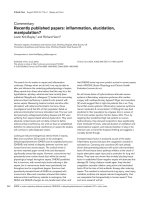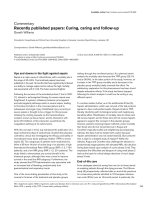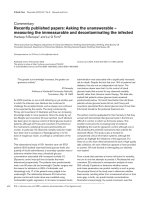Báo cáo y học: "Recently published papers: Sugar, soap and statins – an unlikely recipe for the critically ill" pdf
Bạn đang xem bản rút gọn của tài liệu. Xem và tải ngay bản đầy đủ của tài liệu tại đây (36.18 KB, 3 trang )
Page 1 of 3
(page number not for citation purposes)
ICU = intensive care unit.
Available online />Abstract
The eagerly awaited SOAP (Sepsis Occurrence in Acutely ill
Patients) study is published and its observational data provide
much of interest, not least in generating further hypotheses on
improving treatment in this challenging group. Glycaemic control in
the critically ill is once more the focus of attention, and we discuss
three studies in this area. Not least among these reports is that
from the van den Bergh group, who provide further data on their
intensive insulin protocol in a more heterogeneous group, namely
medical intensive care unit patients. Finally, we discuss another
good reason to take statins.
“Doctors are men who prescribe medicines of which they
know little, to cure diseases of which they know less, in
human beings of whom they know nothing”
Francois-Marie Arouet Voltaire
Some nonphysicians may argue that little has changed since
the 18th century. However, the advent of the clinical trial and
multicentre studies may have helped to shed some light on
practice. To this end the results of the SOAP (Sepsis
Occurrence in Acutely ill Patients) study [1], published
recently in Critical Care Medicine, will cause a stir. That
prospective study of 3147 patients took place in early May
2002 and joins the ranks of other such epidemiological work
on the subject. The study was endorsed by the European
Society of Intensive Care Medicine, and 24 European
countries were involved, encompassing almost 200 intensive
care units (ICUs). Patients were followed for up to 60 days,
or until discharge or death if this occurred before 60 days.
The volume of data collected is impressive, and further insight
into outcomes from sepsis, as defined by the classical
consensus conference criteria, can be gleaned.
The incidence of sepsis approached 40% (37.4%), with the
lung being the commonest site of infection [1].
Unsurprisingly, Staphylococcus aureus was the most
frequent organism, but rather worryingly 14% of isolates were
methicillin resistant. There was a marked difference in the
frequency of sepsis between countries, and higher
frequencies of sepsis were mirrored by higher ICU mortality
rates. It is difficult to correlate this finding with any one factor
but it may well reflect regional differences in ICU resources
as well as variations in case-mix and thresholds for ICU
admission. The multivariate analysis applied to the data
provides few surprises. Patients with sepsis had a longer
length of stay both in the ICU and in hospital, and they had
more severe organ dysfunction and higher mortality rates. The
prognostic variables for ICU mortality included the usual
suspects. Age, cancer, medical admission and septic shock
were all associated with a worse outcome. Also, an observed
increase in patient mortality was associated with the degree
of organ dysfunction, but interestingly there was little
difference between the sepsis and nonsepsis groups in this
regard, cementing the view that organ dysfunction is a bad
thing whether sepsis is present or not.
The SOAP study [1] is interesting and a triumph in
organizational terms, but its findings also contain one extremely
important point that may provide a focus for several more
studies. Cumulative fluid balance within the first 72 hours of
onset of sepsis was an independent predictor of outcome in
the sepsis group. Although multivariate analysis has attracted
many criticisms, including its inability to account for
unmeasured differences, this is still an intriguing finding,
especially when it is viewed in tandem with findings reported
by Rivers and coworkers [2]. Perhaps this indicates that early,
appropriate recognition of critical illness, and treatment of it,
should be our aim and with this may come improved outcomes.
One aim in treatment that has been embraced with great
vigour is that of intensive insulin therapy and tight glycaemic
control in the critically ill. This followed the landmark study by
Commentary
Recently published papers: Sugar, soap and statins – an unlikely
recipe for the critically ill
David Bacon and Lui G Forni
Department of Critical Care, Worthing General Hospital, Worthing, UK
Corresponding author: Lui G Forni,
Published: 10 April 2006 Critical Care 2006, 10:140 (doi:10.1186/cc4900)
This article is online at />© 2006 BioMed Central Ltd
Page 2 of 3
(page number not for citation purposes)
Critical Care Vol 10 No 2 Bacon and Forni
van den Berghe and colleagues in 2001 [3], who demon-
strated an impressive mortality benefit in surgical intensive
care patients, such that previously ignored elevations in blood
glucose have now become high priority therapeutic targets.
That study and the wholesale implementation of intensive
insulin therapy based on its findings have not been without
their critics, given that the original work represented data
from a single centre that was biased toward cardiac surgery
with a relatively low severity of illness. Few data are currently
available regarding treatment of the more severely ill. How-
ever, the impact on clinical practice is unquestionable. Recently
published guidelines of the Surviving Sepsis Campaign [4]
recommend intensive insulin therapy despite a lack of over-
whelming evidence. It was hoped that the latest study from
Belgium [5] would yield answers to some of these questions.
Van den Berghe and colleagues [5] enrolled 1200 patients
over a 3-year period from 2002 on an intention-to-treat basis.
All were patients on a medical ICU who had a predicted
length of stay of at least 3 days on the unit. Patients not for
active treatment were excluded. Patients were randomly
assigned either to intensive insulin therapy (insulin infusions to
keep blood glucose between 4.4 and 6.1 mmol/l [80–
110 mg/dl]) or to standard therapy (insulin to be administered
if blood glucose exceeded 12 mmol/l [215 mg/dl] and eased
when levels fell below 10 mmol/l [180 mg/dl]). The results
were somewhat surprising. Overall, there was no significant
difference in survival at 28 and 90 days for each patient group.
More strikingly, there appeared to be a worse outcome in the
intensive therapy group who were discharged to the general
wards fewer than 3 days from admission to ICU. However, in
keeping with their previous work, the investigators found that
patients who were on the ICU for longer than 3 days exhibited
an apparent morbidity and survival benefit, which was
significant following intensive insulin therapy. This included
reductions in days to wean from intermittent positive pressure
ventilation, incidence of renal impairment (but not incidence of
dialysis) and incidence of hyperbilirubinaemia.
The investigators suggested that, for the protective effect of
strict normoglycaemia to be realized, the therapy must be
established for longer than the first few days of the illness,
although they proposed no reason for the observed increase
in mortality in the group treated for fewer than 3 days [5].
What is clear is that hypoglycaemia was far more frequently
observed in the intensive treatment than in the conservative
group, and this was demonstrated to be an independent
predictor of death.
Leading on from this, Egi and colleagues [6] reported on a
study designed to assess the risks and benefits of intensive
insulin therapy in postoperative ICU patients. They selected a
cohort of patients with clinical features similar to those of the
cohort described by van den Berghe and coworkers [3]. For
the 783 patients studied, all information on glucose control
was retrieved, although none of the units employed specific
protocols for insulin therapy. There overall findings suggested
that 102 patients would have to be treated with intensive
insulin treatment to prevent one death. They also calculated
that treatment of 13 patients would lead to one episode of
harm, in this instance severe hypoglycaemia (defined as
< 2.2 mmol/l). However, these results did vary widely
depending on the clinical setting and case-mix. This is a
difficult study to draw major conclusions from. Clearly,
comparing the ultimate end-point with transient hypoglycaemia
is far from ideal, but the study does alert us to the fact that
application of intensive insulin therapy may not, as suggested
previously, be universally applicable and is not without risk.
This latter point was addressed by Vriesendorp and co-
workers [7]. Since employing more intensive insulin treatment
regimens, those investigators have noticed an increase in
hypoglycaemic events, similar to those reported by van den
Berghe and colleagues. They therefore set out to identify the
factors that may make this such a common scenario within
their patient population. Over a 2-year period they examined
all patients who had at least one episode of hypoglycaemia
during the ICU stay. A total of 156 patients were identified
from 2272 in all. Vriesendorp and coworkers examined
several parameters and found that diabetes, sepsis, need for
inotropic support, use of bicarbonate-buffered replacement
fluid during haemofiltration and decreased nutrition without
insulin adjustment were independently associated with
hypoglycaemia.
So where do these studies leave us? Certainly, the days of
ignoring high blood sugars on the basis of an ‘adaptive
response’ are gone. However, the dictatorial constraints of
the van den Bergh protocol may not be applicable to those of
us who work in a predominantly medical ICU. Perhaps the
way forward may well be a slightly more relaxed approach,
certainly during the first 72 hours of admission, similar to the
proposal by Finney and colleagues in 2003 [8] who
speculated that a blood glucose level below 8.0 mmol/l
should be the preferred treatment aim. This could be followed
by a more intensive regimen to maximize any potential benefit.
Assuming that we have identified our patient with sepsis and
of course treated the blood glucose appropriately, what
then? When we are dispensing our polypharmacy, we should
perhaps consider continuing the patient’s statin therapy.
Some studies have implied that statins may have diverse
effects other than just lowering lipids. Hackam and
colleagues [9], in the Lancet, reported that statin therapy in
patients with cardiovascular disease may have additional
benefits in preventing sepsis. In their observational study
conducted in 141,487 patients in Canada, they found
reduced rates of sepsis, severe sepsis and fatal sepsis. This
protective association was observed in all groups including
those deemed to be at higher risk, such as patients with
diabetes and renal failure. Although not ICU based, this is an
interesting study and well worth a look.
Page 3 of 3
(page number not for citation purposes)
Competing interests
The authors declare that they have no competing interests.
References
1. Vincent J-L, Sakr Y, Sprung CL, Ranieri VM, Reinhart K, Gerlach
H, Moreno R, Carlet J, Le Gall J-R, Payen D: Sepsis in European
intensive care units: results of the SOAP study. Crit Care Med
2006, 34:344-353.
2. Rivers E, Nguyen B, Havstad S, Ressler J, Muzzin A, Knoblich B,
Peterson E, Tomlanovich M: Early goal-directed therapy in the
treatment of severe sepsis and septic shock. N Engl J Med
2001, 345:1368-1377.
3. van den Berghe G, Wouters P, Weekers F, Verwaest C, Bruyn-
inckx F, Schetz M, Vlasselaers D, Ferdinande P, Lauwers P, Bouil-
lon R: Intensive insulin therapy in the surgical intensive care
unit. N Engl J Med 2001, 345:1359-1367.
4. Dellinger RP, Carlet JM, Masur H, Gerlach H, Calandra T, Cohen
J, Gea-Banacloche J, Keh D, Marshall JC, Parker MM, et al.: Sur-
viving Sepsis Campaign guidelines for management of
severe sepsis and septic shock. Crit Care Med 2004, 32:858-
873.
5. van den Berghe G, Wilmer A, Hermans G, Meersseman W,
Wouters PJ, Milants RN, Wijngaerden EV, Bobbaers H, Bouillon
R: Intensive insulin therapy in the medical ICU. N Engl J Med
2006, 354:449-461.
6. Egi M, Bellomo R, Stachowski E, French CJ, Hart G, Stow P, Li
W, Bates S. Intensive insulin therapy in postoperative inten-
sive care patients. Am J Respir Crit Care Med 2006, 173:407-
413.
7. Vriesendorp TM, van Santen S, DeVries H, de Jonge E, Rosendaal
FR, Schultz MJ, Hoekstra JBL: Predisposing factors for hypogly-
caemia in the intensive care unit. Crit Care Med 2006, 34:96-
101.
8. Finney SJ, Zekveld C, Elia A, Evans TW: Glucose control and
mortality in critically ill patients. JAMA 2003, 290:2041-2047.
9. Hackam DJ, Mamdani M, Ping L, Redelmeier DA: Statins and
sepsis in patients with cardiovascular disease: a population-
based cohort analysis. Lancet 2006, 367:413-418.
Available online />

